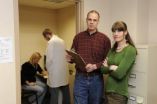New study finds 9,500 ED visits related to cribs, playpens and bassinets each year in US
Researchers call for improved product design, increased enforcement of safety standards and greater efforts to increase awareness of their potential dangers to young children
2011-02-20
(Press-News.org) Parents and caregivers have traditionally relied on cribs, playpens and bassinets to protect children while they sleep. The massive crib recalls followed by the announcement in December 2010 by the United States Consumer Product Safety Commission (CPSC) to ban drop-side cribs have caused many families to question the safety of these products. A new study conducted by researchers at the Center for Injury Research and Policy of The Research Institute at Nationwide Children's Hospital examined injuries associated with cribs, playpens and bassinets among children younger than 2 years of age from 1990 through 2008. During the 19-year study period, an average of 9,500 injuries and more than 100 deaths related to these products were seen in U.S. emergency departments each year.
According to the study, being released online February 21 and appearing in the March 2011 print issue of Pediatrics, the majority of the injuries involved cribs (83 percent) and the most common injury diagnosis was soft-tissue injury (34 percent), followed by concussion or head injury (21 percent). The head or neck was the most frequently injured body region (40 percent), followed by the face (28 percent). Two-thirds of the injuries were the result of a fall, and the percentage of injuries attributed to falls increased with age.
"Despite the attention given to crib safety over the past two decades, the number of injuries and deaths associated with these products remains unacceptably high," said Gary Smith, MD, senior author of the study and director of the Center for Injury Research and Policy. "Unlike other child products that require adult supervision for their safe use, cribs, playpens and bassinets must be held to a higher standard because we expect parents to leave their child unattended in them and walk away with peace of mind."
"Educating caregivers about the proper use and potential dangers of these products is an important part of making cribs safer for children, but education alone is not enough," said Dr. Smith, also a Professor of Pediatrics at The Ohio State University College of Medicine. "Innovations in product design and manufacture can provide automatic protection that does not rely on actions of caregivers to keep children safe."
In recent years, organizations such as the CPSC and the American Academy of Pediatrics have amplified their efforts to increase crib safety. The CPSC has issued recalls of more than 11 million cribs and has prohibited the manufacture, sale or lease of drop-side cribs starting in June 2011. Continued strengthening and enforcement of crib safety standards will protect more young children from harm.
Despite the potential risks, cribs are still considered to be the safest location where parents can place infants to sleep. There are several steps parents and caregivers should take when selecting a crib for their child:
Pay close attention to the crib you select.
Select a crib that meets all current safety standards, does not have a drop side and is not old, broken or modified.
Avoid cribs with cutouts or decorative corner posts or knobs that stick up more than 1/16th of an inch
Measure the slats to make sure they are not more than 2 and 3/8 inches apart
Visit www.recalls.gov to make sure the crib has not been recalled
Make sure the mattress fits tightly into the crib. If you can fit more than two fingers between the mattress and the crib, you need a bigger mattress
Frequently examine the crib to make sure it is in good repair and that there are no loose parts
Carefully read and follow all assembly instructions
When putting your child in a crib to sleep, consider the following:
Always place your baby on his or her back to sleep
Remember that a bare crib is best. Do not add pillows, blankets, sleep positioners, stuffed animals or bumpers to the crib
Crib tents and mesh canopies are not safe to use over cribs. Children can become trapped or strangle in them if they try to get out
Avoid placing the crib near a window to prevent falls and possible strangulation from cords from window blinds or shades
Monitor your child's developmental milestones and make changes to the crib as needed.
Once your child can push up on his hands and knees or is 5 months old (whichever occurs first), remove all mobiles and hanging toys
When your child can pull herself up or stand, adjust the mattress to the lowest position. Having the crib sides at least 26 inches above the mattress can help prevent falls
Check the manufacturer's instructions to know when your child will outgrow the crib. This generally occurs when your child reaches 35 inches in height
If using a bassinet or playpen, make sure they have a sturdy, wide base and that your child meets all height and weight limits.
This is the first nationally representative study to examine injuries to young children associated with cribs, playpens and bassinets that were treated in United States emergency departments. Data for this study were collected from the National Electronic Injury Surveillance System, which is operated by the CPSC.
INFORMATION:
The Center for Injury Research and Policy (CIRP) of The Research Institute at Nationwide Children's Hospital works globally to reduce injury-related pediatric death and disabilities. With innovative research as its core, CIRP works to continually improve the scientific understanding of the epidemiology, biomechanics, prevention, acute treatment and rehabilitation of injuries. CIRP serves as a pioneer by translating cutting edge injury research into education, policy and advances in clinical care. For related injury prevention materials or to learn more about CIRP visit http://www.nationwidechildrens.org/injury-research-and-policy. While visiting our website, sign up for the RSS feed in the What's New section of our media center to receive e-mail updates of our latest news.
END
ELSE PRESS RELEASES FROM THIS DATE:
2011-02-20
Inducing labor without a medical reason is associated with negative outcomes for the mother, including increased rates of cesarean delivery, greater blood loss and an extended length of stay in the hospital, and does not provide any benefit for the newborn. As the number of scheduled deliveries continues to climb, it is important for physicians and mothers-to-be to understand the risks associated with elective induction.
The new findings, published in the February issue of the Journal of Reproductive Medicine, only apply to women having their first child, and may not ...
2011-02-20
BUFFALO, N.Y. -- Among the many differences between girls and boys, add the effects from caffeine -- physiological, behavioral and subjective -- to the list.
Results of a double-blind, placebo-controlled, dose-response study of the response of youth to caffeine found that, in general, boys get a greater rush and more energy from caffeine than girls.
Boys also reported they felt that caffeine had a positive effect on their athletic performance. Girls didn't report on this issue.
The study, conducted by Jennifer L. Temple, PhD, a neurobiologist and assistant professor ...
2011-02-20
Unlike alcohol problems and antisocial behavior, depression doesn’t
decline with age in addiction-prone women in their 30s and 40s – it
continues to increase, a new study led by University of Michigan Health
System researchers found.
The longitudinal analysis examined the influences of the women’s
histories, family life and neighborhood instability on their alcoholism
symptoms, antisocial behavior and depression over a 12-year period
covering the earlier years of marriage and motherhood.
The research, published in Development and Psychopathology, is part of
an ...
2011-02-20
ROCHESTER, Minn. - Mayo Clinic researchers confirmed that patients who receive therapeutic hypothermia after resuscitation from cardiac arrest have favorable chances of surviving the event and recovering good functional status. In therapeutic hypothermia, a patient's body temperature is cooled to 33 degrees Celsius following resuscitation from cardiac arrest, in order to slow the brain's metabolism and protect the brain against the damage initiated by the lack of blood flow and oxygenation. This study was published in the December 2010 issue of Annals of Neurology.
"Therapeutic ...
2011-02-20
AMES, Iowa -- Why would anyone falsely confess to a crime they didn't commit? It seems illogical, but according to The Innocence Project, there have been 266 post-conviction DNA exonerations since 1989 -- 25 percent of which involved a false confession.
A new Iowa State University study may shed light on one reason for those false confessions. In two experiments simulating choices suspects face in police interrogations, undergraduate subjects altered their behavior to confess to illegal activities in order to relieve short-term distress (the proximal consequence) while ...
2011-02-20
Yet some athletes deliberately train at high altitude, with less oxygen, so they can perform better. Their bodies adapt to the reduced oxygen.
Now a doctor at the University of Colorado School of Medicine has explored the relationship between lack of oxygen, called hypoxia, and the inflammation that can injure or kill some patients who undergo surgery. In a liver transplant, for example, the surgery and anesthesiology can go perfectly yet the new liver will fail because of hypoxia.
"Understanding how hypoxia is linked to inflammation may help save lives of people who ...
2011-02-20
A powerful solar flare has ushered in the largest space weather storm in atleast four years and has already disrupted some ground communications on Earth, said University of Colorado Boulder Professor Daniel Baker, an internationally known space weather expert.
Classified as a Class X flare, the Feb. 15 event also spewed billions of tons of charged particles toward Earth in what are called coronal mass ejections and ignited a geomagnetic storm in Earth's magnetic field, said Baker, director of CU-Boulder's Laboratory for Atmospheric and Space Physics. Such powerful ejections ...
2011-02-20
When studying relationships, psychological scientists have often focused on how couples fight. But how they recover from a fight is important, too. According to a new study published in Psychological Science, a journal of the Association for Psychological Science, couples' abilities to bounce back from conflict may depend on what both partners were like as infants.
Researchers at the University of Minnesota have been following a cohort of people since before they were born, in the mid-1970s. When the subjects were about 20 years old, they visited the lab with their romantic ...
2011-02-20
LOS ANGELES (February 18, 2011) – Scientists at the Children's Center for Cancer and Blood Diseases and The Saban Research Institute of Children's Hospital Los Angeles today announced a breakthrough discovery in understanding how the body fights leukemia. They have identified a protein called CD19-ligand (CD19-L) located on the surface of certain white blood cells that facilitates the recognition and destruction of leukemia cells by the immune system. This work represents the first report of a bioengineered version of CD19-L, a recombinant human biotherapeutic agent, ...
2011-02-20
PITTSBURGH, Feb. 18 – Only one out of more than 1,900 people evaluated met the American Heart Association (AHA) definition of ideal cardiovascular health, according to a new study led by researchers at the University of Pittsburgh School of Medicine. Their findings were recently published online in Circulation.
Ideal cardiovascular health is the combination of these seven factors: nonsmoking, a body mass index less than 25, goal-level physical activity and healthy diet, untreated cholesterol below 200, blood pressure below 120/80 and fasting blood sugar below 100, explained ...
LAST 30 PRESS RELEASES:
[Press-News.org] New study finds 9,500 ED visits related to cribs, playpens and bassinets each year in US
Researchers call for improved product design, increased enforcement of safety standards and greater efforts to increase awareness of their potential dangers to young children


